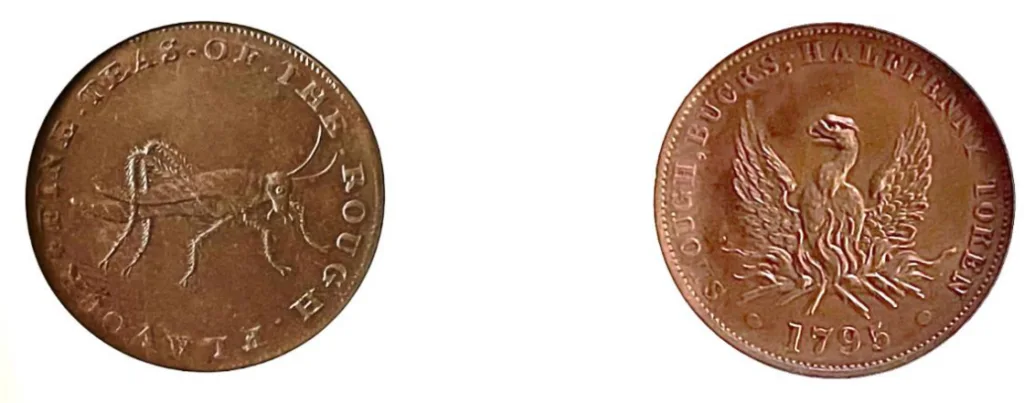Collecting & Grading Condor Tokens
By: Your Newsletter Editor!

DH 13 – 19
Penny
I have enjoyed collecting Conder Token, also known as “English Provincial Coinage”, for about as long as I have had interest in early American, European and Russian (kopeks) copper. I enjoy the idea that that I can find AU/MS examples of Conder Tokens from the late 18th and early 19th century at very reasonable prices. As an example, the above 1787 Wales Anglesey Mines penny token was from the late Robbie Brown collection, and it is a nice example of that AU/MS example I am always looking to find.

Right: 1795 Buckinghamshire-Slough D&H-27 Half Penny
Another enjoyable aspect of the Conders is the variation of devices that you might find on both the obverse and reverse of these tokens. For example, I recently added the above 1795 Middlesex D&H-904 for just over a hundred dollars in MS-63 (NGC). Imagine what you would pay for a 1795 large cent in that condition, if you could find one. But then again, what does the Grasshopper represent and how many folks collect Grasshoppers? Interestingly, the D&H-904 is a highly sought after token.
More on the Grasshopper next quarter! The 1795 Buckinghamshire-Slough (also shown above) is another NGC MS-63 that I was able to capture in Steve & Lisa Davis’s recent auction (Numismatic Auctions, LLC). The bird, which I refer to as the “War Eagle”, caught my attention.
In general, with this series, I don’t like to use descriptive modifiers that I find to be subjective, such as “nice”, “super”, or a + or – after a grade. Descriptors that are important and not as subjective in my opinion are: color, surface quality, luster and die condition (i.e. die state). The one thing that is not subjective is WEAR!
The English grading system is used on all these tokens, and grading abbreviations are as we use in the USA. However, you must remember that a British EF is an American AU, and that a British AU can have slight rub or be as good as a MS 62.
Consider the following for grading Conder Tokens
UNC — Uncirculated. A gem will have wonderful luster and no marks.
AU — or “Almost Uncirculated”. In the English grading system, this does not exist. However, even the British have started to use the term. It is essentially uncirculated, but has a tiny bit of rub on the highest point of the token, usually caused by a sliding coin cabinet drawer many years ago, or by slight mishandling. The piece can be beautiful or scruffy — but the wear should show only on one or two high spots, not on the whole piece.
Extra Fine. In the English grading system, this indicates very light rub over more than one high point — it can be over the high points on both sides, but quite light. The details are still wonderful. This condition is usually considered AU by American graders.
Very Fine. In the English grading system, this token is beginning to show flatness but still retains much of the detail. It is very much the average circulated piece.
Fine. The piece exhibits much wear — most of the detail is flat, but all letters and devices are readable.
Very Good. The piece exhibits much wear. Not only is the detail flat, but some of the detail may be missing entirely. The legends have not yet worn into the edge of the rims, however.
Good. Worn to the point where the lettering around the rims may have begun to wear into the rim, and the detail is indistinct.
Things that affect eye appeal, the key to desirability, are: color/natural toning, luster (cartwheel), nice surfaces, and sharpness of strike, within a given grade range. On the other hand, tokens with unattractive marks, scratches, stains, corrosion spots, weak strikes, rim dents, and other problems will be less desirable, and sale for much less.
A piece with high eye appeal will sell for the top dollar in its grade range — and a piece with low eye appeal will sell for less money than average in the grade range. This is where subjectivity comes in — many can grade, but what appeals to one person does not always appeal to another. Wear alone does not fix the value of a piece and should not. More on Conders next quarter!